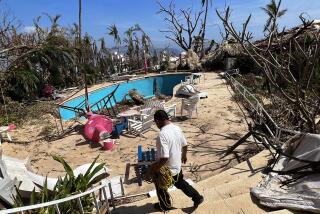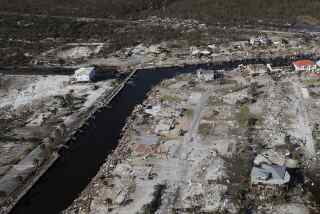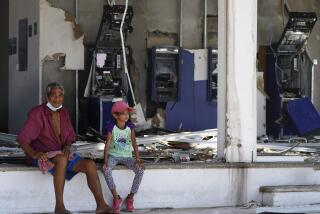Pensacola tragedy gives way to hope
Mud turned to a crust and then to smelly dust Saturday on the downtown streets of this battered city, where talk of recovery from Hurricane Ivan was more ambitious than simply putting things back the way they were.
“There is so much to be rebuilt that maybe we can look at the big picture without constraints,” City Manager Thomas Bonfield said. “I guess this is maybe tragedy and opportunity.”
Ivan savaged Pensacola as it made landfall early Thursday on the Alabama coast near the Florida state line, pulling down historic buildings, flooding neighborhoods and slicing through the bridges, roads and power lines that knit a community together.
With at least 18 dead just in Florida and more than 350,000 homes and businesses without power from Pensacola to Panama City, residents looked at the ruined downtown Saturday and tried to imagine a better Pensacola rising from the rubble.
As Pensacola traded its port-town personality for trendy shops and restaurants during the past few decades, city leaders, activists and developers often fought over the direction to take, downtown leaders said.
“This might be what we need to bring us together,” said Regina Baniakas, 43, an accountant whose flooded office on South Palafox Street had the stench of soggy ceiling tiles and drywall. “There’s always been a lot of fussing about what to do in downtown.”
R.M. “Peter” McDavid, 59, an attorney and owner of a downtown building that looked as though it had been attacked by bulldozers, said things couldn’t be the same.
“It’s going to change the city, and it’s going to change it dynamically and dramatically for the better,” McDavid said.
These and other expressions of optimism came as state officials outlined huge problems left by the third hurricane to hit the state in five weeks.
In addition to widespread power outages and shortages of fuel and food, badly damaged bridges to Pensacola Beach and other shoreline communities remained closed, along with Interstate 10 east of the city.
State officials in Tallahassee urged residents who evacuated before the storm to stay away from damaged areas awhile longer.
“We’re now moving into a phase where the problem is not the storm itself,” said Dr. John Agwunobi, secretary of the Florida Department of Health.
State officials announced that emergency contracts have been made for temporary repairs to damaged bridges on I-10 and U.S. Highways 98 and 90.
The westbound I-10 bridge will be restored by moving a portion of the remaining eastbound lanes of the bridge. The $26.5 million contract gives two firms until Oct. 11 to do the work, but they will get bonuses if they finish sooner. Damage to the bridge foundation was worse than expected, officials said Saturday.
Two lanes already are open on the U.S. Highway 90 bridge, and officials are spending $500,000 to open the other two by Wednesday. Officials hope to restore two temporary lanes for U.S. Highway 98 by Sept. 28 under a $4.9 million contract.
Authorities Saturday identified the driver killed in the damaged truck left sitting on the edge of the broken I-10 bridge. The body of Robert Molina Alvarado, 46, of Donna, Texas, was recovered Friday night in the cab of the partly submerged truck, which was packed in mud, officials said.
“He apparently stopped, and then the bridge collapsed,” said Col. Chris Knight, head of the Florida Highway Patrol. “If he was still moving, he would have gone right into the bay.”
Authorities found no other vehicles in the bay and said they still don’t know why Alvarado was out in the storm.
Hundreds of urban search-and-rescue workers scoured demolished neighborhoods, some using tracking dogs to look for victims in the rubble and along flooded riverbanks.
Fourteen people still were missing Saturday in Escambia County and at least a dozen in Santa Rosa County. It wasn’t clear whether they had evacuated without notifying relatives or whether they were in danger, said Sonya Smith, spokeswomen for the county emergency-operations center.
Ivan and its remnants were being blamed for 44 deaths nationally, along with 70 more in the Caribbean. Utility companies said more than 1.3 million homes and businesses from Pennsylvania to Florida had no electricity Saturday.
The storm dumped as much as 12 inches of rain Friday on the western tip of North Carolina and sent the Ohio River spilling over the banks in parts of Ohio and West Virginia. In Wheeling, W.Va., the river was expected to crest today at 46 feet, almost 10 feet above flood stage.
Upriver in Pittsburgh, where two rivers join to become the Ohio, Point State Park downtown was underwater Saturday. Heavy rain was reported in parts of northern New Jersey and eastern New York.
Skies were clear in Pensacola, where workers struggled to restore power.
“I’ve worked on a lot of storm damage and never seen anything like this,” said Sam Brown, 41, a Gulf Power line technician, repairing a power line near the Pensacola Civic Center. “It’s not just a section of town but everywhere you go.”
Ivan flooded downtown Pensacola with water rising from Escambia Bay -- the inland waterway separated from the Gulf of Mexico by the beachfront islands.
The savage force of that storm surge surprised residents.
“My heavens, that’s part of the marina all the way over there,” said Jerry Maygarden, 55, a retired state representative, who pointed to boat docks ripped from the bay and dumped a block away in Seville Square park.
In Pensacola’s historic downtown, buildings were demolished, left as little more than a pile of bricks first laid in the 1800s.
More than 100 large boats at the Palafox Pier marina were dumped in a pile at one end of the marina after the storm surge broke apart docks.
At the Pensacola Naval Air Station, home of the Blue Angels precision flight team, officials estimate the damages at hundreds of millions of dollars. Although no airplanes in the fleet were damaged, many vintage planes at the National Museum of Naval Aviation were destroyed.
Several historic buildings along the waterfront, some dating from the 19th century, crumbled during the storm.
“The airfield already is functional, so we’re making a comeback,” said Capt. John Pruitt, who rode out the storm in a fortified building on the base.
Even as residents coped with Ivan, weather forecasters continued to monitor Tropical Storm Jeanne, spinning hundreds of miles out in the Atlantic Ocean. Scott Spratt of the National Weather Service in Melbourne said that Jeanne is likely to slowly travel north during the next three days, remaining well east of the Bahamas and Florida.
“It may do a loop and just stay stationary out there,” Spratt said. “It’s close enough to continue to watch it but far enough away to not need to make any preparations for an impact.”
By late Saturday, Pensacola was still a city with few ordinary pulses of life.
Most activity was at sites set up in the city and surrounding Escambia County for distribution of ice, water and food.
“Anywhere there’s a distribution center, we’re talking about lines of cars 2 or 3 miles long,” said Bill Walsh, chief helicopter pilot for the Sheriff’s Office.
A Walgreens pharmacy was one of the few businesses open. Jerry’s Drive In at Perry Avenue and Scenic Highway was selling $2 cheeseburgers as fast as owner Jimmy Halstead could make them.
At Apple Grocery, farther north on Scenic Highway, owner David Apple was swamped with customers.
Apple also saw opportunity in Ivan’s destruction. Winds tore off a part of his store’s façade that he looks forward to replacing.
“I never did like that awning,” he said.
Bob Mahlburg and Melissa Harris of the Sentinel staff contributed to this report. Information from The Associated Press also was used. Kevin Spear can be reached at 407-420-5062 or kspear@orlandosentinel.com.
More to Read
Start your day right
Sign up for Essential California for news, features and recommendations from the L.A. Times and beyond in your inbox six days a week.
You may occasionally receive promotional content from the Los Angeles Times.






